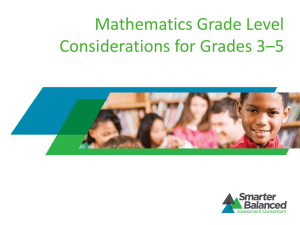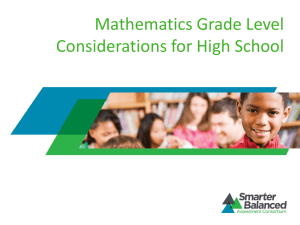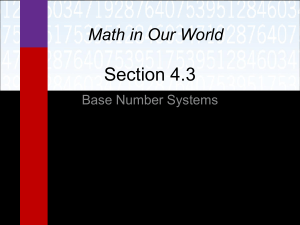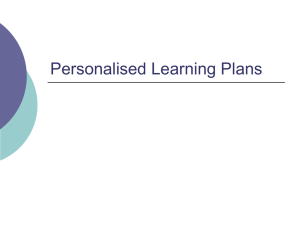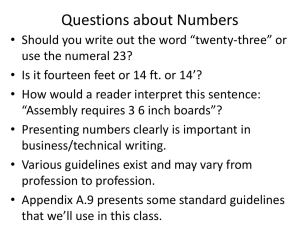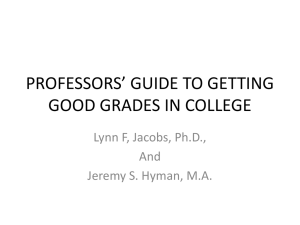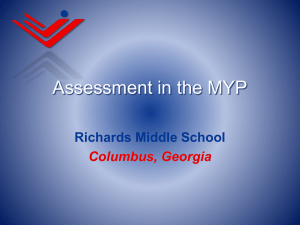Mathematics-Grade-Level-Considerations-for-Grades-6
advertisement
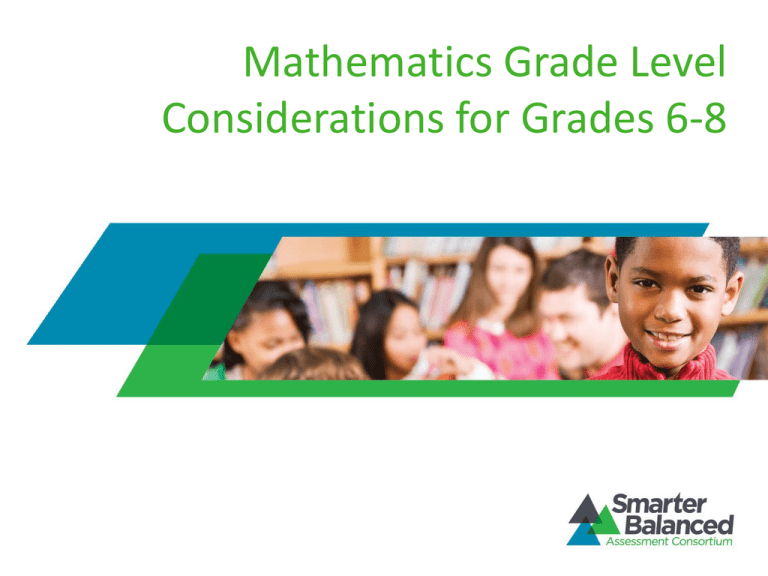
Mathematics Grade Level Considerations for Grades 6-8 Considerations for Grades 6–8 • • • • • • Vocabulary Style Guide Representation of numbers Contexts Item Difficulty Assessment Targets Vocabulary • • Items must be written so students can easily understand the item or task. Use vocabulary at or below grade-level. Style Overview of Mathematics Style Conventions Specific to Middle School Grades • Use variables to indicate missing values in equations • Use the product dot rather than the multiplication symbol except in scientific notation 2x + 4 = 16 2 12 a 2a 1.2 × 104 = 12,000 • • In grade 8, use the terms translate, reflect, and rotate Use graphics or tables to present information in order to reduce the amount of reading Translate Reflect Rotate Words vs. Numerals • Use numerals for numbers that are used to solve a problem Sarah sold 9 adult tickets for a total of $45. What was the price of each adult ticket? • Use numerals for numbers that appear in equations 19 + x = 35 Words vs. Numerals • • • Use words for a number that is the first word in a sentence Use words for numbers zero through nine Use numerals for: – Numbers 10 and above – Numbers that precede abbreviated units of measure (e.g., 10 cm, 8 sq. ft.) – Numbers that precede or follow symbols such as the percent sign or dollar sign (e.g., 5%, $9.32) – Dates and years (e.g., July 4) – Time of day that appears before A.M. and P.M. (e.g., 3 A.M., 12:30 P.M.) – Ordered pairs and coordinates (e.g., (3,4)) Commas in Numbers • Use commas in numbers: – With five or more digits (e.g., 90,000) – With four digits if the number appears with numbers of five or more digits (e.g., 1,000 + 5,000 + 10,000) – Written as words (e.g., seventy-three thousand, one hundred) • Do not use commas in: – Numbers with four digits if all numbers with which it appears contain four or less digits (e.g., 50 + 200 + 1000) – Compound measures (e.g., 5 feet 9 inches tall) Contexts • Appropriate contexts – Popular sports – Bicycle riding – Making nominal purchases – Making and reading maps and floor plans – School related activities • Inappropriate contexts – Expensive or regional sports – Purchases that are unusual for students Item Difficulty • • Items should include a range of difficulty Anticipated difficulty for sample items Claim 1 Concepts and Procedures: Students can explain and apply mathematical concepts and interpret and carry out mathematical procedures with precision and fluency. • • • • Selected Response Constructed Response Technology-Enhanced Extended Response and Performance Tasks Assessment Targets Measured in Grades 6–8 • • • • • • Ratios and Proportional Relationships The Number System Expressions and Equations Geometry Statistics and Probability Functions Ratios and Proportional Relationships • • Grade 6: Ratios introduced Grade 7: Extended to proportional relationships The Number System • • Grades 6 & 7: Rational numbers Grade 8: Irrational numbers Expressions and Equations • • • Grade 6: Introduce algebraic expressions Grade 7: Create expressions and equations and use to solve problems Grade 8: Analyze and solve more complex problems Geometry • • • Grade 6: Area, surface area, and volume Grade 7: Drawing and constructing figures Grade 8: Congruence, similarity, and the Pythagorean Theorem Statistics and Probability • • • Grade 6: Statistic and probability introduced Grade 7: Sampling, inferences, and probability Grade 8: Associations in bivariate data Functions • Grade 8: Defining, evaluating, comparing, and modeling functions Claim 2 – Problem Solving • • • Selected Response, Constructed Response, Extended Response, and TechnologyEnhanced items that focus on problem solving Items and tasks require students to construct their own pathway to the solution Relevant verbs include: – understand, solve, apply, describe, illustrate, interpret, and analyze Claim 3 – Communicating Reasoning • • Constructed Response, Extended Response, and Technology-Enhanced items and tasks that focus on mathematical reasoning Relevant verbs include: – understand, explain, justify, prove, derive, assess, illustrate, and analyze Claim 4 – Modeling and Data Analysis • • • • Performance Tasks and collections of Extended Response items Real world problems Draw upon knowledge and skills articulated in the progression of standards up to the grade being assessed Relevant verbs include: – model, construct, compare, investigate, build, interpret, estimate, analyze, summarize, represent, solve, evaluate, extend, and apply Claims 2, 3, and 4 • • Assessment Targets for Claims 2, 3, and 4 are not divided into a grade-by-grade description A general set of assessment targets applicable across grade levels Middle School Mathematics Grade Level Considerations • • Vocabulary, style, context, and item difficulty Claims from the Smarter Balanced Mathematics Content Specifications
